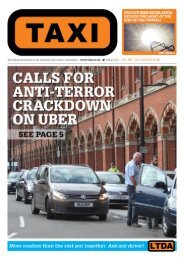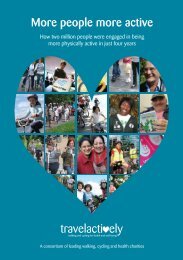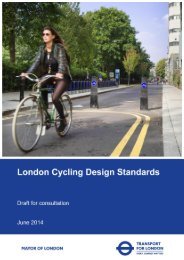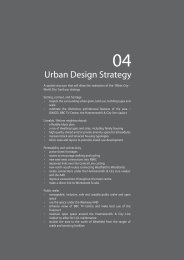Travel in London Travel in London
travel-in-london-report-8
travel-in-london-report-8
Create successful ePaper yourself
Turn your PDF publications into a flip-book with our unique Google optimized e-Paper software.
3. <strong>Travel</strong> trends by mode<br />
• Passenger traffic through <strong>London</strong>’s ma<strong>in</strong> airports has also closely reflected the<br />
fortunes of the wider economy, with term<strong>in</strong>al passengers at <strong>London</strong> area<br />
airports <strong>in</strong>creas<strong>in</strong>g by just 1.4 per cent overall between 2008 and 2014. Between<br />
2007 and 2010 term<strong>in</strong>al passengers decreased by an average of 3.1 per cent<br />
each year.<br />
• The number of licensed taxis and licensed taxi drivers <strong>in</strong> <strong>London</strong> has rema<strong>in</strong>ed<br />
broadly stable over the period between 2008 and 2014, at about 22,500 and<br />
25,000 respectively. However, recent technology change has seen the number<br />
of licensed private hire vehicles and drivers <strong>in</strong>crease at a rapid rate – up by a net<br />
27.2 and 41.1 per cent respectively between 2008 and 2014, and up by 18.8<br />
and 19.9 per cent over the latest year alone. However, this does not appear to<br />
have fed through directly to significantly <strong>in</strong>creased traffic levels.<br />
3.3 Modal trends: Bus<br />
Figure 3.1 shows the long-term trend for bus patronage <strong>in</strong> <strong>London</strong>. The bus has<br />
been one of <strong>London</strong>’s transport success stories, with the historic pattern of slowly<br />
decl<strong>in</strong><strong>in</strong>g patronage be<strong>in</strong>g dramatically reversed <strong>in</strong> the late 1990s to one of strong<br />
growth. Over the 13 years from 2000/01 to 2013/14, the number of bus journey<br />
stages <strong>in</strong> <strong>London</strong> <strong>in</strong>creased by 59.9 per cent, and passenger-kilometres grew by<br />
73.8 per cent.<br />
The rate of growth has stabilised <strong>in</strong> more recent years, this correspond<strong>in</strong>g to a<br />
slow<strong>in</strong>g of the rate of <strong>in</strong>crease <strong>in</strong> bus services. Over the period between 2008/09<br />
and 2014/15 the <strong>in</strong>crease <strong>in</strong> patronage was 6.2 per cent <strong>in</strong> terms of journey stages,<br />
and 6 per cent <strong>in</strong> terms of passenger kilometres. In the most recent year it was just<br />
0.1 per cent <strong>in</strong> terms of journey stages and 0.1 per cent <strong>in</strong> terms of passenger<br />
kilometres.<br />
Figure 3.1 Passenger kilometres and journey stages travelled by bus.<br />
25,000<br />
Passenger kilometres<br />
Journey stages<br />
3,000<br />
Passenger kilometres (millions)<br />
20,000<br />
15,000<br />
10,000<br />
5,000<br />
New estimation method for<br />
bus <strong>in</strong>troduced <strong>in</strong> 2007/08.<br />
2,500<br />
2,000<br />
1,500<br />
1,000<br />
500<br />
Passenger journey stages (millions)<br />
0<br />
-<br />
Source: TfL Service Performance data.<br />
51 <strong>Travel</strong> <strong>in</strong> <strong>London</strong>, Report 8








